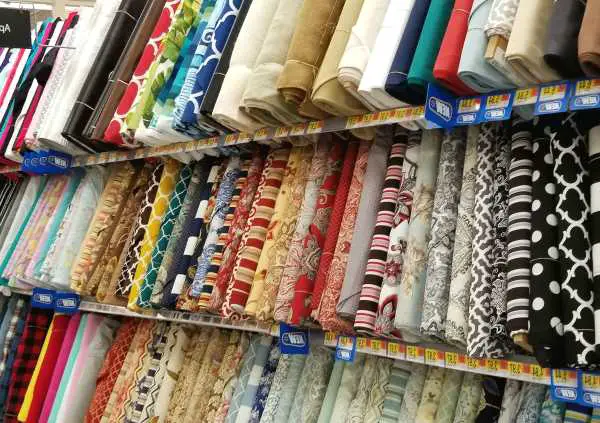A fabric bolt is a unit of measurement used in the textile industry. It is equal to 40 yards or 36.58 meters. Most fabrics are sold in bolts, which vary in width depending on the type of fabric. The standard width of a Fabric bolt is typically between 44 and 60 inches (111.8 and 152.4 cm). The width can vary slightly depending on the manufacturer or country where the fabric was produced.
Fabric bolts are used to measure both woven and knitted fabrics. Woven fabrics are made on looms and are held together by interlacing yarns that run perpendicular to each other, while knit fabrics are created by looping yarns together. The term “bolt” comes from the way that these early fabrics were stored: rolled onto wooden dowels or spindles called “bolts”.
Today, most fabrics are sold in rolls rather than bolts, but the term “bolt” is still used as a unit of measurement. When buying fabric, it’s important to know how much you need so that you can purchase the correct amount; otherwise you may end up with too little or too much material.
To calculate the number of bolts you need, first determine the width of fabric you require in yards or meters. Then divide this number by 36 (for yards) or 39 (for meters), which is equal to one bolt.
For example, if you need 10 yards of 54-inch wide fabric, you would divide 10 by 36 to get 0.2778 bolts, rounded up to 1 bolt since partial bolts cannot be purchased (you would need at least 0.5 for a half-bolt). In contrast, if you only needed 5 yards then you could round down to 0 bolts since no partial yardage can be cut from a roll.
Knowing the standard width of different types of fabrics can also help you estimate how much material you will need for a project:
Broadcloth: This tightly woven cotton fabric has a very fine surface texture and is available in various weights ranging from light to heavy duty; it is typically between 44 and 60 inches wide (111 – 152cm).
Canvas: A sturdy cotton cloth with a plain weave that is often used for painting canvases or as an outdoor fabric; it ranges in width from 36 – 60 inches (91 – 152cm).
Chambray: A lightweight cotton fabric with a plain weave and dyed warp threads; chambray shirts are popular because they have the look of denim without being as heavy; chambray typically measures between 42 – 58 inches wide (106 – 147cm).
Corduroy: A durable cotton twill fabric with raised velvet cords running parallel to each other; corduroy pants are popular winter wear because they are warm yet breathable; corduroy is generally available in widths ranging from 28 – 42 inches wide (71 – 106cm), although some extra wide varieties measure upto 56 inches wide (142cm).
Denim: A sturdy cotton twill fabric often used for jeans; denim come sin many different weights and colors but all denims have indigo dyein their warp threads; denim ranges in width from 36 – 58 inches wide (91 – 147cm).
Flannel: A soft woolen or Cotton Fabric with a napped finish on one or both sides that is usually brushed to raise fibers from the underlying weave . flannel is often used for shirts,pajama’s,and other garments .it is available in widths ranging from 36 – 60 inches wide (91 – 152cm).
Fleece: A synthetic wool fabric often used for jackets and sweatshirts; fleece is available in many different weights and colors but all have a brushed finish on one side to raise the fibers from the underlying weave; it typically measures between 50 – 60 inches wide (127 – 152cm). –
Gingham: A light cotton or linen fabric with a checks pattern; gingham is often used for summer clothing or picnicking because it doesn’t wrinkle easily; gingham is usually between 42 – 44 inches wide (106 – 111cm).
Lace: A delicate fabric made of interwoven threads that can be made from various materials like cotton, linen, silk, or synthetics; lace is often used as an embellishment on clothing or other fabrics and is available in widths ranging from 30 – 54 inches wide (76 – 137cm).
Linen: A sturdy fiber made from the flax plant that has a slightly nubby surface texture; linen wrinkles easily but also has a tendency to look better as it ages; linen fabrics are available in widths ranging from 36 – 60 inches wide (91 – 152cm). –
Muslin: A plain woven cotton fabric that is very lightweight and airy; muslin is often used for making patterns or prototypes since it is easy to sew and drape; muslin typically measures between 44 – 58 inches wide (111 – 147cm).
Organza: A sheer synthetic fabric with a crisp hand that is often used for evening wear or wedding dresses; organza ranges in width from 30 – 54 inches wide (76 – 137cm).
Ribbon: A narrow strip of fabric that can be made from various materials like satin, grosgrain, velvet, etc. Ribbon is often used for decorative purposes such as trimming or wrapping gifts, Ribbon comes in many different widths but the most common are 1/8 inch (3mm), 1/4 inch (6mm), 3/8 inch (9mm), and 1/2 inch (12mm).
Sateen: A lustrous cotton fabric with a smooth hand and slight sheen; sateen is similar to broadcloth but has more yarns per inch in the warp which gives it a softer feel and more luster; sateen typically measures between 44 – 60 inches wide (111 – 152cm) .
Satine :A glossy cotton fabric with a very smooth surface that was originally made of silk. Satine is still most commonly found in widths of 44–60 inches (111–152cms) but also comes in a wide range of other widths and colors.
